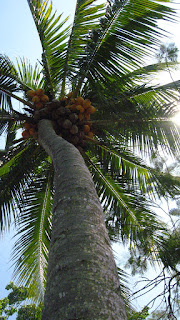 Buah keranji ( Malay ) is Dialium indum ( a.k.a. D. cochinchinenses, D. laurinum ), also known as velvet tamarind, and luk yee ( Thai ). It is a member of subfamily Caesalpinioideae of family Fabaceae.
Buah keranji ( Malay ) is Dialium indum ( a.k.a. D. cochinchinenses, D. laurinum ), also known as velvet tamarind, and luk yee ( Thai ). It is a member of subfamily Caesalpinioideae of family Fabaceae.Keranji is native to S.E.Asian. Supposedly closely associated with the local Malays, as it was featured in a popular Malay poem ( pantun ).
The Malay pantun reads like this :
“Sorong papan tarik papan
Buah keranji di dalam perahu
Suruh makan engkau makan
Suruh mengaji engkau tak tahu”
A search in internet found very little information of the fruit. Nevertheless, the name ‘keranji’ is familiar within local community, often used in name of places, roads, even apartments & housing estates, yet not many had actually seen or tasted the fruit, especially the younger generation.
 During the 1980s, kids back then have not much choice of snacks. Keranji was one of the cheapest, somehow palatable and fun too. Two person with a handsome stock of keranji would play a game of ‘keranji-fighting’. Each holding a keranji and push toward each other, whomever’s keranji cracks, shall surrender the bet, normally a keranji.
During the 1980s, kids back then have not much choice of snacks. Keranji was one of the cheapest, somehow palatable and fun too. Two person with a handsome stock of keranji would play a game of ‘keranji-fighting’. Each holding a keranji and push toward each other, whomever’s keranji cracks, shall surrender the bet, normally a keranji. The fruit is edible, has a powdery texture, taste sweet and sour, similar to tamarind ( Tamarindus indica ). Fresh fruit’s skin is dark blue in colour. The fruit of oval shape. When fresh, the flesh is of light brown in colour, turning darker when aged.
Yet, no records of extensive cultivation reported. The keranji fruits occasionally found in local market may be of wild stands.













